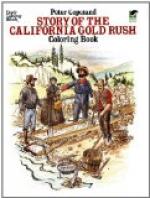To become better acquainted with birds, let us call them before us by classes, beginning with our sea-birds and those round the bays and on the coast. Some of these not only swim but dive in the salt waters, and to this class of divers belong the grebe, loon, murre, and puffin. They dive at the flash of a gun, and after what seems a long time, come up far away from the spot the hunter aimed at. These birds usually nest on bare, rocky cliffs near the ocean, or on islands like the Farallones, and their large green eggs hatch out nestlings that are ugly and awkward and helpless on land. But they ride the great ocean-breakers, or dive into their clear depths easily and gracefully; and as they live upon fish or small sea-creatures, the divers only seek land to roost at night and to raise their young.
Next come the gulls, who belong to a class known as “long-winged swimmers.” They have strong wings and fly great distances, and with their webbed feet swim well, too. Most of the sea-gulls are white with a gray coat on their backs, but they look snowy-white as they fly. You may see them walking about the wharves, or perching on roofs and piles watching for food, and seeming very tame as they pick up bits of bread or the refuse floating in the water. They follow steamers for miles, scarcely moving their wings as they float in the air; and if you throw a cracker from the deck, some gull will make a swift swoop and snatch it before the cracker reaches the water.
Far out on the Pacific the albatross sails proudly on his broad wings, and cares nothing for high winds or storms. He rests and sleeps on the billows at night with his little companions, the stormy petrels. He is the largest and strongest of our birds of flight, the very king of the sea. The stormy petrels are not much larger than a swallow. Sailors call them. “Mother Carey’s chickens,” and are sure a storm is coming up when petrels follow the ship. The albatross, petrel, and a gull-like bird called a shearwater belong to the “tube-nosed swimmers,” on account of their curious long beaks.
Along the coast, and wading in the shallow waters around the bays, are some strange birds known as pelicans and shags. They are good fishers, and drive the darting, finny fellows before them as they wade in the water till they can see and gobble them up. Most waders have under their beaks a skin-pocket deep enough to hold a fish while carrying it to their nestlings, or making ready to swallow it. All of these sea-birds raise their young as far from the shore and from hunters as possible. Great flocks of them roost on islands fifteen or twenty miles out in the ocean, and fly into the bays every morning.
Wild ducks, geese, the herons, mud-hens, sandpipers, and curlews are marsh and shore birds that feed and wade in the shallow salt water, and nest on the banks or, like the heron, in trees near the bay. The heron is a frog-catcher, and he will stand very still on his long legs and patiently wait till the frog, thinking him gone, swims near. Then one dart of the long bill captures froggy, and the heron waits for another. You know the red-head, green mallard, canvas-back, and small teal ducks, no doubt, and have seen the flocks of wild geese flying and calling in the sky, or standing like patches of snow as they feed in the marshes or grain-fields.




